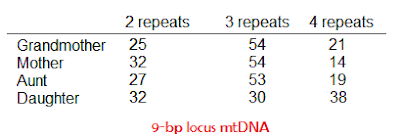Today's post adds some more information to yesterday's post on the 9-bp deletion in human mtDNA's Coding Region.
More Europeans with the deletion
My previous post menitoned African, Asian, Amerindian and two Portuguese carriers of the 9-bp deletion, today I will add some more European data:
1. Haplogroup I, from Italy.[1] and Haplogroup I, from Spain [2]
2. Another paper (Thomas et al., 1998) reports two individuals from Glasgow (2 in N=115), Scotland (forgive my lazyness, but this paper was published in 1998 and does not specify the haplogroup it does mention the mutations, so those interested may classify these two persons). I will quote this paper extensively because it is intereresting:
The paper found these two persons who were unrelated and noticed that their mtDNA Control Regions were quite different, which lead them to conclude that the mutation was not recent and predated the arrival of H. sapiens to Europe:
"The sharing of these rare polymorphisms suggests that the 9-bp deletion in these two individuals stems from a single mutation event. The CR sequences of these individuals di¡er by eight nucleotides, suggesting that their common ancestor was not recent and probably lived before the arrival of modern humans in Europe."
[...]
"date their most common ancestor to about 50 000 years before present [...] it is interesting to note that the estimated date is earlier than the arrival of modern humans in Europe." [3]
The paper points out that such an ancient origin means that "this polymorphism should be present elsewhere in Europe and we suggest that it would be rewarding to do additional surveys for the deletion" [3], as mentioned above, it is found in Europe but at very low frequencies which supports its ancient origin.
The paper does not contemplate the possibility of the "one-repeat" sequence (that is, the 9-bp deletion) being the archaich ancestral state while all repeat sequences (2, 3 and 4 repeats plus insertions of partial segments of the 9-bp sequence) are the mutations. It considers the basal state as the "tandem repeat" and all mutations (the deletion) or multiple repeats as derived from the tandem sequence.
They do however note that "In this study, we have not addressed the effect of different repeat numbers on general fitness or replication efficiency." [3], which as I mentioned in yesterday's post is something to be considered since it appears that the 9-bp deletion is correlated to certain diseases.
The authors also found one female individual (1 in N=115) carrying not one, but several insertions of the CCCCCTCTA motif and studied her maternal lineage and concluded that the individual was heteroplasmic.
Heteroplasmy.
A heteroplasmic individual has more than one (hetero = "various", plasmy = "kinds") type of mtDNA in his or her cells.
Our cells have hundreds of mitochondria and they mutate in a random fashion. Since they cannot repair their mtDNA, these mutations accumulate over time in our cells which contain a mix of mutant and wild-type mtDNA. A woman carrying the heteroplasmy will transmit them in variable amounts to her offspring. The outcome can be healthy children or on the contrary, a child affected by a terrible disorder.
They studied this woman's mother, aunt and grandmother and found that the frequency of the different repeat values which was conserved from grandmother to daughters (her mother and aunt), changed in one generation (from her mother to hereself).
The Four repeats increased at the expense of the three repeat mutation, which is at odds with the population frequencies we mentioned in our previous post, where the 3 repeat is more frequent than the 4 repeat. Probably in heteroplasmic individuals some other factors such as natural selection are acting on the relative frequencies of repeats.
Comments
Detecting two Southern Mediterranean individuals belonging to Hg. I carrying the mutation while others do not carry it [2] (samples from Spain and North Africa) seem to point to a common origin of this mutation in a specific group of Hg. I individuals before their arrival to the region and their later spread to Spain and Italy.
In a similar manner, the two Scots with the deletion also suggest a pre-European origin for the mutation ~ 50 kya. [3]. This is indeed interesting as it supports my hunch that the deletion is indeed archaic and found in many haplogroups.
The heteroplasmic woman is also interesting since she shows that the mutations tend to an increase in repeat numbers and not a decrease (i.e. a deletion from tandem to one-repeat), which means that it may not have originated independently in different populations, but once, long ago in Africa and survives until now as a trans-haplogroup trait, which if carefully analysed would allow us to detect the inconsistencies in our current haplo-trees!
Sources
[1] Torroni A. Petrozzi M., Santolamazza P., Sellrro D., Cruciani F. and Scozzari R., (1995). About the "Asian"-Specific 9-bp Deletion of mtDNA. Am. J. Hum. Genet. 57:507-508, 1995
[2] GenealogiaMolecular.com. (2007), Linajes mayores del genoma mitocondrial trazan antiguas expansiones humanas (in Spanish)
[3] Mark G. Thomas, Charles E. Cook, Kevin W. P. Miller, Michael J. Waring and Erika Hagelberg, (1998). Phil.Trans. R. Soc. Lond. B 955-965
Patagonian Monsters - Cryptozoology, Myths & legends in Patagonia Copyright 2009-2014 by Austin Whittall ©

















No comments:
Post a Comment